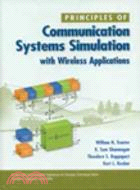| FindBook |
|
有 1 項符合
shanmugan的圖書 |
 |
$ 1064 | PRINCIPLES OF COMMUNICATION SYSTEMS SIMULATION WITH WIRELESS APPLICATIONS
作者:KOSBAR,RAPPAPORT,SHANMUGAN,TRANTER 出版社:全華圖書 出版日期:2004-01-15 語言:英文 規格:精裝 / 560頁 / 普通級/ 單色印刷 / 初版  看圖書介紹 看圖書介紹
|
|
|
圖書介紹 - 資料來源:博客來 評分:
圖書名稱:PRINCIPLES OF COMMUNICATION SYSTEMS SIMULATION WITH WIRELESS APPLICATIONS
內容簡介
This book presents a comprehensive overview of computer-based simulation models and methodologies for communication systems. Because such models are a useful and necessary tool in the design, analysis, and performance of communication systems as well as a means of evaluating design changes in these systems, Computer Aided Design and Analysis of Communication Systems with Wireless Applications uses MATLAB as a basis for developing effective computer-based simulations. Such simulations are intended to capture the essential features of the system to assure accurate results while minimizing the complexity of the model, ensuring execution of the simulation code in a reasonable amount of time. Among the fundamental topics covered are probability, random, process, and estimation theory and their roles in the design of computer-based simulations.Preface.I. INTRODUCTION. 1. The Role of Simulation. Examples of Complexity. Multidisciplinary Aspects of Simulation. Models. Deterministic and Stochastic Simulations. The Role of Simulation. Software Packages for Simulation. A Word of Warning. The Use of MATLAB. Outline of the Book. Further Reading. 2. Simulation Methodology. Introduction. Aspects of Methodology. Performance Estimation. Summary. Further Reading. Problems. II. FUNDAMENTAL CONCEPTS AND TECHNIQUES. 3. Sampling and Quantizing. Sampling. Quantizing. Reconstruction and Interpolation. The Simulation Sampling Frequency. Summary. Further Reading. References. Problems. 4. Lowpass Simulation Models for Bandpass Signals and Systems. The Lowpass Complex Envelope for Bandpass Signals. Linear Bandpass Systems. Multicarrier Signals. Nonlinear and Time-Varying Systems. Summary. Further Reading. References. Problems. Appendix A: MATLAB Program QAMDEMO. Appendix B: Proof of Input-Output Relationship. 5. Filter Models and Simulation Techniques. Introduction. IIR and FIR Filters. IIR and FIR Filter Implementations. IIR Filters: Synthesis Techniques and Filter Characteristics. FIR Filters: Synthesis Techniques and Filter Characteristics. Summary. Further Reading. References. Problems. Appendix A: Raised Cosine Pulse Example. Appendix B: Square Root Raised Cosine Pulse Example. Appendix C: MATLAB Code and Data for Example 5.11. 6. Case Study: Phase-Locked Loops and Differential Equation Methods. Basic Phase-Locked Loop Concepts. First-Order and Second-Order Loops. Case Study: Simulating the PLL. Solving Differential Equations Using Simulation. Summary. Further Reading. References. Problems. Appendix A: PLL Simulation Program. Appendix B: Preprocessor for PLL Example Simulation. Appendix C: PLL Postprocessor. Appendix D: MATLAB Code for Example 6.3. 7. Generating and Processing Random Signals. Stationary and Ergodic Processes. Uniform Random Number Generators. Mapping Uniform RVs to an Arbitrary pdf. Generating Uncorrelated Gaussian Random Numbers. Generating Correlated Gaussian Random Numbers. Establishing a pdf and a PSD. PN Sequence Generators. Signal Processing. Summary. Further Reading. References. Problems. Appendix A: MATLAB Code for Example 7.11. Main Program: c7 Jakes.m. 8. Postprocessing. Basic Graphical Techniques. Estimation. Coding. Summary. Further Reading. References. Problems. Appendix A: MATLAB Code for Example 8.1. 9. Introduction to Monte Carlo Methods. Fundamental Concepts. Application to Communications Systems—The AWGN Channel. Monte Carlo Integration. Summary. Further Reading. References. Problems. 10. Monte Carlo Simulation of Communication Systems. Two Monte Carlo Examples. Semianalytic Techniques. Summary. References. Problems. Appendix A: Simulation Code for Example 10.1. Appendix B: Simulation Code for Example 10.2. Appendix C: Simulation Code for Example 10.3. Appendix D: Simulation Code for Example 10.4. 11. Methodology for Simulating a Wireless System. System-Level Simplifications and Sampling Rate Considerations. Overall Methodology. Summary. Further Reading. References. Problems. III. ADVANCED MODELS AND SIMULATION TECHNIQUES. 12. Modeling and Simulation of Nonlinearities. Introduction. Modeling and Simulation of Memoryless Nonlinearities. Modeling and Simulation of Nonlinearities with Memory. Techniques for Solving Nonlinear Differential Equations. PLL Example. Summary. Further Reading. References. Problems. Appendix A: Saleh's Model. Appendix B: MATLAB Code for Example 12.2. 13. Modeling and Simulation of Time-Varying Systems. Introduction. Models for LTV Systems. Random Process Models. Simulation Models for LTV Systems. MATLAB Examples. Summary. Further Reading. References. Problems. Appendix A: Code for MATLAB Example 1. Appendix B: Code for MATLAB Example 2. 14. Modeling and Simulation of Waveform Channels. Introduction. Wired and Guided Wave Channels. Radio Channels. Multipath Fading Channels. Modeling Multipath Fading Channels. Random Process Models. Simulation Methodology. Summary. Further Reading. References. Problems. Appendix A: MATLAB Code for Example 14.1. Appendix B: MATLAB Code for Example 14.2. 15. Discrete Channel Models. Introduction. Discrete Memoryless Channel Models. Markov Models for Discrete Channels with Memory. Example HMMs—Gilbert and Fritchman Models. Estimation of Markov Model Parameters. Two Examples. Summary. Further Reading. References. Problems. Appendix A: Error Vector Generation. Appendix B: The Baum-Welch Algorithm. Appendix C: The Semi-Hidden Markov Model. Appendix D: Run-Length Code Generation. Appendix E: Determination of Error-Free Distribution. 16. Efficient Simulation Techniques. Tail Extrapolation. pdf Estimators. Importance Sampling. Summary. Further Reading. References. Problems. Appendix A: MATLAB Code for Example 16.3. 17. Case Study: Simulation of a Cellular Radio System. Introduction. Cellular Radio System. Simulation Methodology. Summary. Further Reading. References. Problems. Appendix A: Program for Generating the Erlang B Chart. Appendix B: Initialization Code for Simulation. Appendix C: Modeling Co-Channel Interference. Appendix D: MATLAB Code for Wilkinson's Method. 18. Two Example Simulations. A Code-Division Multiple Access System. FDM System with a Nonlinear Satellite Transponder. References. Appendix A: MATLAB Code for CDMA Example. Appendix B: Preprocessors for CDMA Application. Appendix C: MATLAB Function c18 errvector.m. Appendix D: MATLAB Code for Satellite FDM Example. Index. About The Authors.
目錄
Preface.
I. INTRODUCTION.
1. The Role of Simulation.
Examples of Complexity. Multidisciplinary Aspects of Simulation. Models. Deterministic and Stochastic Simulations. The Role of Simulation. Software Packages for Simulation. A Word of Warning. The Use of MATLAB. Outline of the Book. Further Reading.
2. Simulation Methodology.
Introduction. Aspects of Methodology. Performance Estimation. Summary. Further Reading. Problems.
II. FUNDAMENTAL CONCEPTS AND TECHNIQUES.
3. Sampling and Quantizing.
Sampling. Quantizing. Reconstruction and Interpolation. The Simulation Sampling Frequency. Summary. Further Reading. References. Problems.
4. Lowpass Simulation Models for Bandpass Signals and Systems.
The Lowpass Complex Envelope for Bandpass Signals. Linear Bandpass Systems. Multicarrier Signals. Nonlinear and Time-Varying Systems. Summary. Further Reading. References. Problems. Appendix A: MATLAB Program QAMDEMO. Appendix B: Proof of Input-Output Relationship.
5. Filter Models and Simulation Techniques.
Introduction. IIR and FIR Filters. IIR and FIR Filter Implementations. IIR Filters: Synthesis Techniques and Filter Characteristics. FIR Filters: Synthesis Techniques and Filter Characteristics. Summary. Further Reading. References. Problems. Appendix A: Raised Cosine Pulse Example. Appendix B: Square Root Raised Cosine Pulse Example. Appendix C: MATLAB Code and Data for Example 5.11.
6. Case Study: Phase-Locked Loops and Differential Equation Methods.
Basic Phase-Locked Loop Concepts. First-Order and Second-Order Loops. Case Study: Simulating the PLL. Solving Differential Equations Using Simulation. Summary. Further Reading. References. Problems. Appendix A: PLL Simulation Program. Appendix B: Preprocessor for PLL Example Simulation. Appendix C: PLL Postprocessor. Appendix D: MATLAB Code for Example 6.3.
7. Generating and Processing Random Signals.
Stationary and Ergodic Processes. Uniform Random Number Generators. Mapping Uniform RVs to an Arbitrary pdf. Generating Uncorrelated Gaussian Random Numbers. Generating Correlated Gaussian Random Numbers. Establishing a pdf and a PSD. PN Sequence Generators. Signal Processing. Summary. Further Reading. References. Problems. Appendix A: MATLAB Code for Example 7.11. Main Program: c7 Jakes.m.
8. Postprocessing.
Basic Graphical Techniques. Estimation. Coding. Summary. Further Reading. References. Problems. Appendix A: MATLAB Code for Example 8.1.
9. Introduction to Monte Carlo Methods.
Fundamental Concepts. Application to Communications Systems—The AWGN Channel. Monte Carlo Integration. Summary. Further Reading. References. Problems.
10. Monte Carlo Simulation of Communication Systems.
Two Monte Carlo Examples. Semianalytic Techniques. Summary. References. Problems. Appendix A: Simulation Code for Example 10.1. Appendix B: Simulation Code for Example 10.2. Appendix C: Simulation Code for Example 10.3. Appendix D: Simulation Code for Example 10.4.
11. Methodology for Simulating a Wireless System.
System-Level Simplifications and Sampling Rate Considerations. Overall Methodology. Summary. Further Reading. References. Problems.
III. ADVANCED MODELS AND SIMULATION TECHNIQUES.
12. Modeling and Simulation of Nonlinearities.
Introduction. Modeling and Simulation of Memoryless Nonlinearities. Modeling and Simulation of Nonlinearities with Memory. Techniques for Solving Nonlinear Differential Equations. PLL Example. Summary. Further Reading. References. Problems. Appendix A: Saleh's Model. Appendix B: MATLAB Code for Example 12.2.
13. Modeling and Simulation of Time-Varying Systems.
Introduction. Models for LTV Systems. Random Process Models. Simulation Models for LTV Systems. MATLAB Examples. Summary. Further Reading. References. Problems. Appendix A: Code for MATLAB Example 1. Appendix B: Code for MATLAB Example 2.
14. Modeling and Simulation of Waveform Channels.
Introduction. Wired and Guided Wave Channels. Radio Channels. Multipath Fading Channels. Modeling Multipath Fading Channels. Random Process Models. Simulation Methodology. Summary. Further Reading. References. Problems. Appendix A: MATLAB Code for Example 14.1. Appendix B: MATLAB Code for Example 14.2.
15. Discrete Channel Models.
Introduction. Discrete Memoryless Channel Models. Markov Models for Discrete Channels with Memory. Example HMMs—Gilbert and Fritchman Models. Estimation of Markov Model Parameters. Two Examples. Summary. Further Reading. References. Problems. Appendix A: Error Vector Generation. Appendix B: The Baum-Welch Algorithm. Appendix C: The Semi-Hidden Markov Model. Appendix D: Run-Length Code Generation. Appendix E: Determination of Error-Free Distribution.
16. Efficient Simulation Techniques.
Tail Extrapolation. pdf Estimators. Importance Sampling. Summary. Further Reading. References. Problems. Appendix A: MATLAB Code for Example 16.3.
17. Case Study: Simulation of a Cellular Radio System.
Introduction. Cellular Radio System. Simulation Methodology. Summary. Further Reading. References. Problems. Appendix A: Program for Generating the Erlang B Chart. Appendix B: Initialization Code for Simulation. Appendix C: Modeling Co-Channel Interference. Appendix D: MATLAB Code for Wilkinson's Method.
18. Two Example Simulations.
A Code-Division Multiple Access System. FDM System with a Nonlinear Satellite Transponder. References. Appendix A: MATLAB Code for CDMA Example. Appendix B: Preprocessors for CDMA Application. Appendix C: MATLAB Function c18 errvector.m. Appendix D: MATLAB Code for Satellite FDM Example.
Index.
About The Authors.
I. INTRODUCTION.
1. The Role of Simulation.
Examples of Complexity. Multidisciplinary Aspects of Simulation. Models. Deterministic and Stochastic Simulations. The Role of Simulation. Software Packages for Simulation. A Word of Warning. The Use of MATLAB. Outline of the Book. Further Reading.
2. Simulation Methodology.
Introduction. Aspects of Methodology. Performance Estimation. Summary. Further Reading. Problems.
II. FUNDAMENTAL CONCEPTS AND TECHNIQUES.
3. Sampling and Quantizing.
Sampling. Quantizing. Reconstruction and Interpolation. The Simulation Sampling Frequency. Summary. Further Reading. References. Problems.
4. Lowpass Simulation Models for Bandpass Signals and Systems.
The Lowpass Complex Envelope for Bandpass Signals. Linear Bandpass Systems. Multicarrier Signals. Nonlinear and Time-Varying Systems. Summary. Further Reading. References. Problems. Appendix A: MATLAB Program QAMDEMO. Appendix B: Proof of Input-Output Relationship.
5. Filter Models and Simulation Techniques.
Introduction. IIR and FIR Filters. IIR and FIR Filter Implementations. IIR Filters: Synthesis Techniques and Filter Characteristics. FIR Filters: Synthesis Techniques and Filter Characteristics. Summary. Further Reading. References. Problems. Appendix A: Raised Cosine Pulse Example. Appendix B: Square Root Raised Cosine Pulse Example. Appendix C: MATLAB Code and Data for Example 5.11.
6. Case Study: Phase-Locked Loops and Differential Equation Methods.
Basic Phase-Locked Loop Concepts. First-Order and Second-Order Loops. Case Study: Simulating the PLL. Solving Differential Equations Using Simulation. Summary. Further Reading. References. Problems. Appendix A: PLL Simulation Program. Appendix B: Preprocessor for PLL Example Simulation. Appendix C: PLL Postprocessor. Appendix D: MATLAB Code for Example 6.3.
7. Generating and Processing Random Signals.
Stationary and Ergodic Processes. Uniform Random Number Generators. Mapping Uniform RVs to an Arbitrary pdf. Generating Uncorrelated Gaussian Random Numbers. Generating Correlated Gaussian Random Numbers. Establishing a pdf and a PSD. PN Sequence Generators. Signal Processing. Summary. Further Reading. References. Problems. Appendix A: MATLAB Code for Example 7.11. Main Program: c7 Jakes.m.
8. Postprocessing.
Basic Graphical Techniques. Estimation. Coding. Summary. Further Reading. References. Problems. Appendix A: MATLAB Code for Example 8.1.
9. Introduction to Monte Carlo Methods.
Fundamental Concepts. Application to Communications Systems—The AWGN Channel. Monte Carlo Integration. Summary. Further Reading. References. Problems.
10. Monte Carlo Simulation of Communication Systems.
Two Monte Carlo Examples. Semianalytic Techniques. Summary. References. Problems. Appendix A: Simulation Code for Example 10.1. Appendix B: Simulation Code for Example 10.2. Appendix C: Simulation Code for Example 10.3. Appendix D: Simulation Code for Example 10.4.
11. Methodology for Simulating a Wireless System.
System-Level Simplifications and Sampling Rate Considerations. Overall Methodology. Summary. Further Reading. References. Problems.
III. ADVANCED MODELS AND SIMULATION TECHNIQUES.
12. Modeling and Simulation of Nonlinearities.
Introduction. Modeling and Simulation of Memoryless Nonlinearities. Modeling and Simulation of Nonlinearities with Memory. Techniques for Solving Nonlinear Differential Equations. PLL Example. Summary. Further Reading. References. Problems. Appendix A: Saleh's Model. Appendix B: MATLAB Code for Example 12.2.
13. Modeling and Simulation of Time-Varying Systems.
Introduction. Models for LTV Systems. Random Process Models. Simulation Models for LTV Systems. MATLAB Examples. Summary. Further Reading. References. Problems. Appendix A: Code for MATLAB Example 1. Appendix B: Code for MATLAB Example 2.
14. Modeling and Simulation of Waveform Channels.
Introduction. Wired and Guided Wave Channels. Radio Channels. Multipath Fading Channels. Modeling Multipath Fading Channels. Random Process Models. Simulation Methodology. Summary. Further Reading. References. Problems. Appendix A: MATLAB Code for Example 14.1. Appendix B: MATLAB Code for Example 14.2.
15. Discrete Channel Models.
Introduction. Discrete Memoryless Channel Models. Markov Models for Discrete Channels with Memory. Example HMMs—Gilbert and Fritchman Models. Estimation of Markov Model Parameters. Two Examples. Summary. Further Reading. References. Problems. Appendix A: Error Vector Generation. Appendix B: The Baum-Welch Algorithm. Appendix C: The Semi-Hidden Markov Model. Appendix D: Run-Length Code Generation. Appendix E: Determination of Error-Free Distribution.
16. Efficient Simulation Techniques.
Tail Extrapolation. pdf Estimators. Importance Sampling. Summary. Further Reading. References. Problems. Appendix A: MATLAB Code for Example 16.3.
17. Case Study: Simulation of a Cellular Radio System.
Introduction. Cellular Radio System. Simulation Methodology. Summary. Further Reading. References. Problems. Appendix A: Program for Generating the Erlang B Chart. Appendix B: Initialization Code for Simulation. Appendix C: Modeling Co-Channel Interference. Appendix D: MATLAB Code for Wilkinson's Method.
18. Two Example Simulations.
A Code-Division Multiple Access System. FDM System with a Nonlinear Satellite Transponder. References. Appendix A: MATLAB Code for CDMA Example. Appendix B: Preprocessors for CDMA Application. Appendix C: MATLAB Function c18 errvector.m. Appendix D: MATLAB Code for Satellite FDM Example.
Index.
About The Authors.
|











